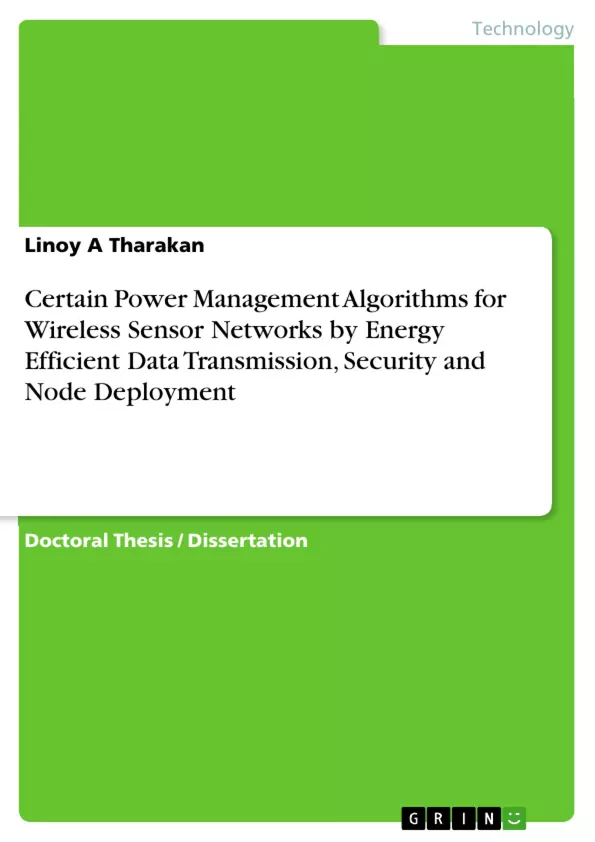Wireless Sensor Networks (WSNs) is fast emerging as prominent study area that attracting considerable research attention globally. The field has seen tremendous development in design and development of application related interfaces with sensor networks. Sensor network finds applications in several domains such as medical, military, home networks, space and so on. Many researchers strongly believe that WSNs can become as important as the internet in the near future. Just as the internet allows access to digital information anywhere, WSNs could easily provide remote interaction with the physical world. It is going to be the backbone of Ubiquitous Computing (UBICOMP).Through local collaboration among sensors, elimination of duplicate data, participation of relevant nodes in the given task etc. can produce a significant difference in energy conservation, thereby increasing the life time of the sensor network.
As the number of nodes increases, data security becomes the most challenging part of the network. The intruders can hack the data any time during processing, transmission or at the receiver end. So, as a popular approach data encryption is the most commendable approach in today’s network. Asymmetric key encryption consumes more energy in processing and so not recommended for WSNs. Symmetric key encryption gives better performance with respect to asymmetric key encryption in WSN applications. It uses less computational power due to relatively effortless mathematical operations, and eventually spends less power. This thesis also proposes a symmetric data encryption through Tabulation method of Boolean function reductionfor the WSNs for secure data transmission. It also suggests a new secure approach, SEEMd, Security Enabled Energy Efficient Middleware algorithmfor the critical data sensing and gives a second chance to the nodes before it falls into to sleep mode for energy management.
WSNs are designed for applications which range from small-size healthcare surveillance systems to large-scale agricultural monitoring or environmental monitoring. Thus, any WSN deployment, data aggregation, processing and communication have to assure minimum Quality of Service (QoS) in the network from application to application. In this circumstances, the proposed algorithms in this thesis proved to be efficient and reliable in energy saving and life time enhancement.
Inhaltsverzeichnis (Table of Contents)
- Introduction
- Literature Survey
- Wireless Sensor Networks
- Types of WSN
- Applications of WSN
- Challenges of WSN
- Energy Efficient Data Transmission in WSN
- Cluster Based Routing Protocols
- Security in WSN
- Node Deployment in WSN
- Proposed Algorithms and Implementations
- Energy Efficient Data Transmission
- Adaptive Energy Efficient Data Transmission
- Dynamic Cluster Head Selection Based on Energy Efficiency
- Security
- Enhanced Security Protocol for WSN
- Node Deployment
- Energy Efficient Node Deployment Algorithm
- Simulation and Results
- Simulation Environment and Parameters
- Performance Evaluation of Proposed Algorithms
- Conclusion
Zielsetzung und Themenschwerpunkte (Objectives and Key Themes)
This thesis aims to investigate and develop power management algorithms for Wireless Sensor Networks (WSNs) by focusing on energy efficient data transmission, security, and node deployment. The research explores the challenges associated with WSNs, such as limited energy resources, security threats, and efficient node deployment, and proposes solutions to address these challenges.
- Energy efficient data transmission in WSNs
- Security in WSNs
- Node deployment strategies for WSNs
- Performance evaluation of proposed algorithms
- Practical implications of the developed algorithms
Zusammenfassung der Kapitel (Chapter Summaries)
The thesis begins with an introduction to WSNs, outlining their types, applications, and challenges. The literature survey comprehensively reviews existing research on energy efficient data transmission, clustering, security, and node deployment in WSNs. This section provides a foundation for understanding the current state of research in the field.
The third chapter introduces the proposed algorithms and their implementations, focusing on energy efficient data transmission, security, and node deployment. This chapter details the design and functionalities of each algorithm, presenting the innovative contributions of the research.
The fourth chapter delves into the simulation and results obtained from evaluating the performance of the proposed algorithms using a suitable simulation environment. This section analyzes the effectiveness and efficiency of the developed algorithms in addressing the identified challenges in WSNs.
The conclusion summarizes the key findings and contributions of the thesis, highlighting the significance of the research in the field of WSNs and outlining future directions for further research.
Schlüsselwörter (Keywords)
This thesis focuses on the following key areas: wireless sensor networks, energy efficiency, data transmission, security, node deployment, clustering, performance evaluation, simulation, and optimization. These keywords represent the core concepts and research areas explored in this work.
- Quote paper
- Linoy A Tharakan (Author), 2017, Certain Power Management Algorithms for Wireless Sensor Networks by Energy Efficient Data Transmission, Security and Node Deployment, Munich, GRIN Verlag, https://www.grin.com/document/388289



